Modification of Polyvinyl Chloride Composites for Radiographic Detection of Polyvinyl Chloride Retained Surgical Items
Abstract
1. Introduction
2. Materials and Methods
2.1. Materials
2.2. Preparation of Compounded Samples
2.3. Rheometrical Measurements
2.4. Scanning Electron Microscopy
2.5. Dynamic Mechanical Analysis
2.6. Atomic Absorption Spectroscopy
2.7. X-ray Measurements
3. Results and Discussion
3.1. Rheological Characterization
3.2. SEM Analysis
3.3. Impact of Radiopaque Fillers on Thermo-Mechanical Properties
3.4. Non-Toxicity of BiOCl Compounds
3.5. Radiopaque Detection
4. Conclusions
Supplementary Materials
Author Contributions
Funding
Acknowledgments
Conflicts of Interest
References
- Sonarkar, R.; Wilkinson, R.; Nazar, Z.; Gajendra, G.; Sonawane, S. Textiloma presenting as a lump in abdomen: A case report. Int. J. Surg. Case Rep. 2020, 77, 206–209. [Google Scholar] [CrossRef]
- Siebert, H. Unbeabsichtigt vergessene Fremdkorper im Operationsgebiet. Medizinische, organisatorische, prophylaktische und rechtliche Aspekte. Rechtsmedizin 2015, 25, 194–200. [Google Scholar] [CrossRef]
- Takahashi, K.; Fukatsu, T.; Oki, S.; Iizuka, Y.; Otsuka, Y.; Sanui, M.; Lefor, A.K. Characteristics of retained foreign bodies and near-miss events in the operating room: A ten-year experience at one institution. J. Anesth. 2022; online ahead of print. [Google Scholar] [CrossRef]
- Cima, R.R.; Kollengode, A.; Garnatz, J.; Storsveen, A.; Weisbrod, C.; Deschamps, C. Incidence and characteristics of potential and actual retained foreign object events in surgical patients. J. Am. Coll. Surg. 2008, 207, 80–87. [Google Scholar] [CrossRef]
- Asiyanbola, B.; Etienne-Cummings, R.; Lewi, J.S. Prevention and diagnosis of retained foreign bodies through the years: Past, present, and future technologies. Technol. Health Care 2012, 20, 379–386. [Google Scholar] [CrossRef]
- Stawicki, S.P.A.; Moffatt-Bruce, S.D.; Ahmed, H.M.; Anderson, H.L.; Balija, T.M.; Bernescu, I.; Chan, L.; Chowayou, L.; Cipolla, J.; Coyle, S.M.; et al. Retained surgical items: A problem yet to be solved. J. Am. Coll. Surg. 2013, 216, 15–22. [Google Scholar] [CrossRef]
- Kaplan, H.J.; Spiera, Z.C.; Feldman, D.L.; Shamamian, P.; Portnoy, B.M.J.; Ioannides, P.; Leitman, I.M. Risk reduction strategy to decrease incidence of retained surgical items. J. Am. Coll. Surg. 2022, 235, 494–499. [Google Scholar] [CrossRef]
- Weprin, S.; Crocerossa, F.; Meyer, D.; Maddra, K.; Valancy, D.; Osardu, R.; Kang, H.S.; Moore, R.H.; Carbonara, U.; Kim, F.J.; et al. Risk factors and preventive strategies for unintentionally retained surgical sharps: A systematic review. Patient Saf. Surg. 2021, 15, 24. [Google Scholar] [CrossRef]
- Peng, J.P.; Ang, S.Y.; Zhou, H.; Nair, A. The effectiveness of radiofrequency scanning technology in preventing retained surgical items: An integrative review. J. Clin. Nurs. 2022; online ahead of print. [Google Scholar] [CrossRef]
- Cochran, K. Guidelines in practice: Prevention of unintentionally retained surgical items. AORN J. 2022, 116, 427–440. [Google Scholar] [CrossRef]
- Houston, K.R.; Brosnan, S.M.; Burk, L.M.; Lee, Y.Z.; Luft, J.C.; Ashby, V.S. Iodinated polyesters as a versatile platform for radiopaque biomaterials. J. Polym. Sci. Part A Polym. Chem. 2017, 55, 2171–2177. [Google Scholar] [CrossRef]
- Rivera, E.J.; Tran, L.A.; Hernandez-Rivera, M.; Yoon, D.; Mikos, A.G.; Rusakova, I.A.; Cheong, B.Y.; Cabreira-Hansen, M.D.; Willerson, J.T.; Perin, E.C.; et al. Bismuth@US-tubes as a potential contrast agent for X-ray imaging applications. J. Mater. Chem. B 2013, 1, 4792–4800. [Google Scholar] [CrossRef]
- Tian, L.; Lee, P.; Singhana, B.; Chen, A.; Qiao, Y.; Lu, L.F.; Martinez, J.O.; Tasciotti, E.; Melancon, A.; Huang, S.; et al. Radiopaque resorbable inferior vena cava filter infused with gold nanoparticles. Sci. Rep. 2017, 7, 2147. [Google Scholar] [CrossRef]
- Kim, S.C. Process technology for development and performance improvement of medical radiation shield made of eco-friendly oyster shell powder. Appl. Sci. 2022, 12, 968. [Google Scholar] [CrossRef]
- Tian, L.; Lu, L.; Feng, J.; Melancon, M.P. Radiopaque nano and polymeric materials for atherosclerosis imaging, embolization and other catheterization procedures. Acta Pharm. Sin. B 2018, 8, 360–370. [Google Scholar] [CrossRef]
- McNally, G.; Ruddy, A.C. Rheological, mechanical and thermal behaviour of radiopaque filled polymers. In Proceedings of the Annual Conference of the Society of Plastics Engineers, ANTEC 2005, Boston, MA, USA, 1–5 May 2005; pp. 2924–2928. [Google Scholar]
- Lu, G.; Kalyon, D.; Yilgor, I.; Yilgor, E. Rheology and processing of baso4-filled medical-grade thermoplastic polyurethane. Polym. Eng. Sci. 2004, 44, 1941–1948. [Google Scholar] [CrossRef]
- Shenoy, A.V. Rheology of Filled Polymer Systems; Springer Science & Business Media: Berlin/Heidelberg, Germany, 2013. [Google Scholar]
- Han, C.D. Rheology and Processing of Polymeric Materials: Volume 2: Polymer Processing; Oxford University Press: New York, NY, USA, 2006. [Google Scholar] [CrossRef]
- Wang, Y.; Huang, S.-W.; Guo, J.-Y. Dynamic mechanical study of clay dispersion in maleated polypropylene/organoclay nanocomposites. Polym. Compos. 2009, 30, 1218–1225. [Google Scholar] [CrossRef]
- Hampikian, J.M.; Heaton, B.C.; Tong, F.C.; Zhang, Z.Q.; Wong, C.P. Mechanical and radiographic properties of a shape memory polymer composite for intracranial aneurysm coils. Mater. Sci. Eng. C-Biomim. Supramol. Syst. 2006, 26, 1373–1379. [Google Scholar] [CrossRef]
- Godinho, J.S.; Moore, I.R.; Mc Nally, G.M.; Murphy, W.R.; Ruddy, A. Influence of barium sulfate on rheological behaviour and mechanical properties of medical-grade PVCs. In Proceedings of the Annual Conference of the Society of Plastics Engineers, ANTEC 2004, Chicago, IL, USA, 16–20 May 2004; pp. 3395–3399. [Google Scholar]
- Kalyon, D.M.; Lu, G.; Yilgor, E.; Yilgor, I. Extrusion of BaSO4 filled medical-grade thermoplastic polyurethane. In Proceedings of the Annual Conference of the Society of Plastics Engineers, ANTEC 2003, Nashville, TN, USA, 4–8 May 2003; pp. 261–265. [Google Scholar]
- Chang, C.-T.; Chen, H.-T.; Girsang, S.P.; Chen, Y.-M.; Wan, D.; Shen, S.-H.; Wang, J. 3D-printed radiopaque polymer composites for the in situ monitoring of biodegradable medical implants. Appl. Mater. Today 2020, 20, 100771. [Google Scholar] [CrossRef]
- Liu, H.; Zhang, Z.; Gao, C.; Bai, Y.; Liu, B.; Wang, W.; Ma, Y.; Saijilafu; Yang, H.; Li, Y.; et al. Enhancing effects of radiopaque agent BaSO4 on mechanical and biocompatibility properties of injectable calcium phosphate composite cement. Mater. Sci. Eng. C 2020, 116, 110904. [Google Scholar] [CrossRef]
- Li, J.Y.; Wang, H.; Guo, Q.P.; Zhu, C.H.; Zhu, X.S.; Han, F.X.; Yang, H.L.; Li, B. Multifunctional Coating to Simultaneously Encapsulate Drug and Prevent Infection of Radiopaque Agent. Int. J. Mol. Sci. 2019, 20, 2055. [Google Scholar] [CrossRef]
- van Hooy-Corstjens, C.S.J.; Bulstra, S.K.; Knetsch, M.L.W.; Geusens, P.; Kuijer, R.; Koole, L.H. Biocompatibility of a new radiopaque iodine-containing acrylic bone cement. J. Biomed. Mater. Res. Part B Appl. Biomater. 2007, 80B, 339–344. [Google Scholar] [CrossRef]
- Deb, S.; Abdulghani, S.; Behiri, J.C. Radiopacity in bone cements using an organo-bismuth compound. Biomaterials 2002, 23, 3387–3393. [Google Scholar] [CrossRef]
- Shannon, A.; JO’Sullivan, K.; Clifford, S.; O’Sullivan, L. Assessment and selection of filler compounds for radiopaque PolyJet multi-material 3D printing for use in clinical settings. Proc. Inst. Mech. Eng. Part H J. Eng. Med. 2022, 236, 740–747. [Google Scholar] [CrossRef]
- Sneha, K.R.; Sailaja, G.S. Intrinsically radiopaque biomaterial assortments: A short review on the physical principles, X-ray imageability, and state-of-the-art developments. J. Mater. Chem. B 2021, 9, 8569–8593. [Google Scholar] [CrossRef]
- Kiran, S.; James, N.R.; Jayakrishnan, A.; Joseph, R. Polyurethane thermoplastic elastomers with inherent radiopacity for biomedical applications. J. Biomed. Mater. Res. Part A 2012, 100A, 3472–3479. [Google Scholar] [CrossRef]
- Aviv, H.; Bartling, S.; Grinberg, I.; Margel, S. Synthesis and characterization of Bi2O3/HSA core-shell nanoparticles for X-ray imaging applications. J. Biomed. Mater. Res. Part B Appl. Biomater. 2013, 101B, 131–138. [Google Scholar] [CrossRef]
- Jagdale, P.; Rovere, M.; Ronca, R.; Vigneri, C.; Bernardini, F.; Calzetta, G.; Tagliaferro, A. Determination of the X-ray attenuation coefficient of bismuth oxychloride nanoplates in polydimethylsiloxane. J. Mater. Sci. 2020, 55, 7095–7105. [Google Scholar] [CrossRef]
- Huang, S.D. Bismuth-based nanoparticles for CT imaging. In Design and Applications of Nanoparticles in Biomedical Imaging; Bulte, J.W.M., Modo, M.M.J., Eds.; Springer: Cham, Switzerland, 2017; pp. 429–444. [Google Scholar] [CrossRef]
- Tian, L.; Lu, L.; Singhana, B.; Jacobsen, M.; Melancon, A.; Melancon, M. Novel radiopaque bismuth nanoparticle coated polydioxanone and comparison of attenuation in pre-clinical and clinical CTs. Med. Phys. 2017, 44, 2820. [Google Scholar]
- Vrsaljko, D.; Leskovac, M.; Blagojevic, S.L.; Kovacevic, V. Interphase phenomena in nanoparticulate filled polyurethane/poly(vinyl acetate) polymer systems. Polym. Eng. Sci. 2008, 48, 1931–1938. [Google Scholar] [CrossRef]
- Slikkerveer, A.; Helmich, R.B.; de Wolff, F.A. Analysis for bismuth in tissue by electrothermal atomic absorption spectrometry. Clin. Chem. 1993, 39, 800–803. [Google Scholar] [CrossRef]
- Nordberg, G.F.; Fowler, B.A.; Nordberg, M.; Friberg, L.T. (Eds.) Handbook on the Toxicology of Metals, 3rd ed.; Elsevier: Burlington, MA, USA, 2007; p. 433. [Google Scholar]
- Ohyama, J.-I.; Maruyama, F.; Dokiya, Y. Determination of bismuth in environmental samples by hydride generation-atomic absorption spectrometry. Anal. Sci. 1987, 3, 413–416. [Google Scholar] [CrossRef]
- Narukawa, T.; Uzawa, A.; Yoshimura, W.; Okutani, T. Effect of cobalt as a chemical modifier for determination of bismuth by electrothermal atomic absorption spectrometry using a tungsten furnace. Anal. Sci. 1998, 14, 779–784. [Google Scholar] [CrossRef]
- Ijaz, H.; Zia, R.; Taj, A.; Jameel, F.; Butt, F.K.; Asim, T.; Jameel, N.; Abbas, W.; Iqbal, M.; Bajwa, S.Z.; et al. Synthesis of BiOCl nanoplatelets as the dual interfaces for the detection of glutathione linked disease biomarkers and biocompatibility assessment in vitro against HCT cell lines model. Appl. Nanosci. 2020, 10, 3569–3576. [Google Scholar] [CrossRef]
- Zelepukin, I.V.; Ivanov, I.N.; Mirkasymov, A.B.; Shevchenko, K.G.; Popov, A.A.; Prasad, P.N.; Kabashin, A.V.; Deyev, S.M. Polymer-coated BiOCl nanosheets for safe and regioselective gastrointestinal X-ray imaging. J. Control. Release 2022, 349, 475–485. [Google Scholar] [CrossRef]
- Repichet, S.; Le Roux, C.; Roques, N.; Dubac, J. BiCl3-catalyzed Friedel–Crafts acylation reactions: Bismuth(III) oxychloride as a water insensitive and recyclable procatalyst. Tetrahedron Lett. 2003, 44, 2037–2040. [Google Scholar] [CrossRef]
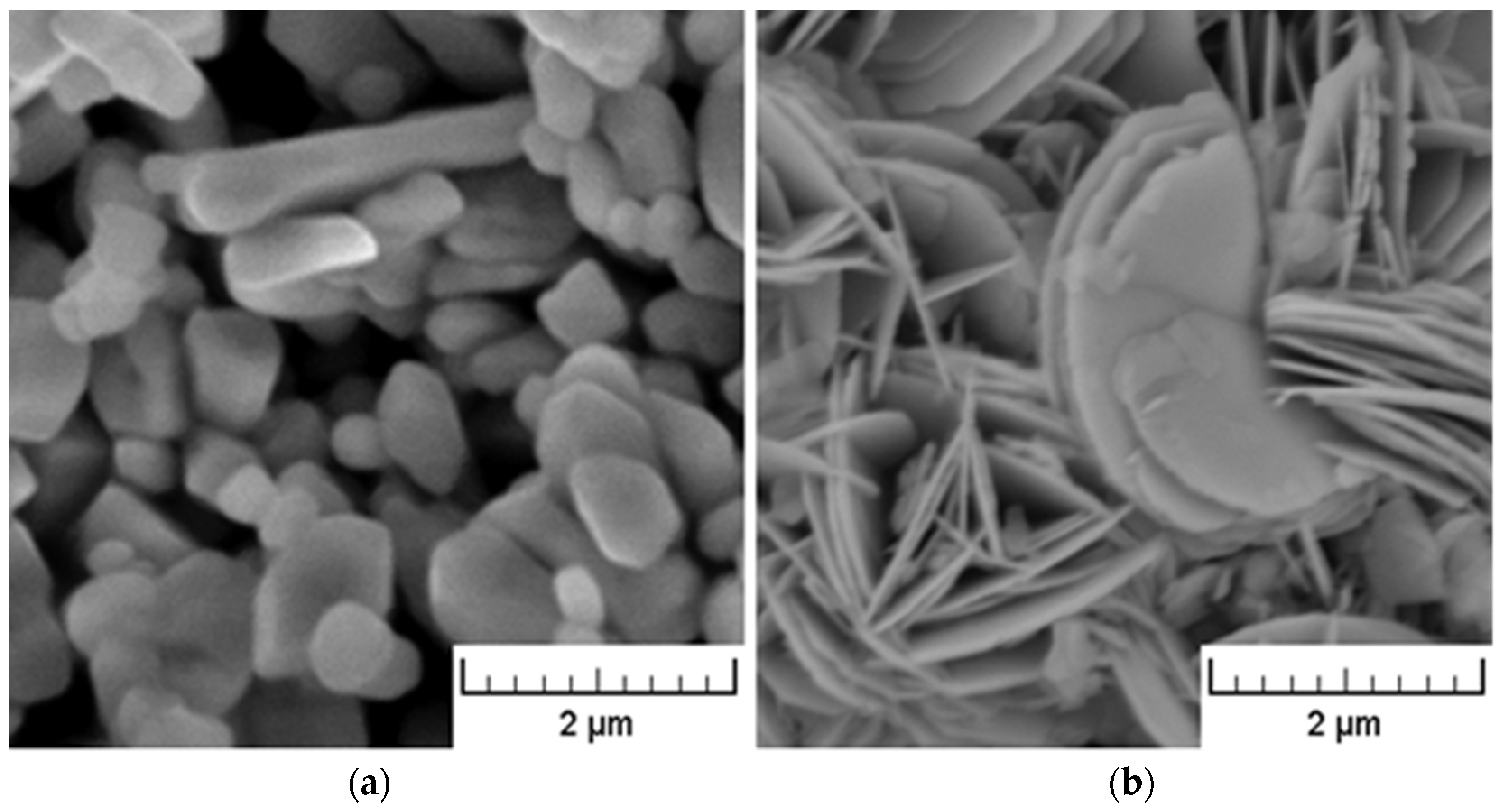

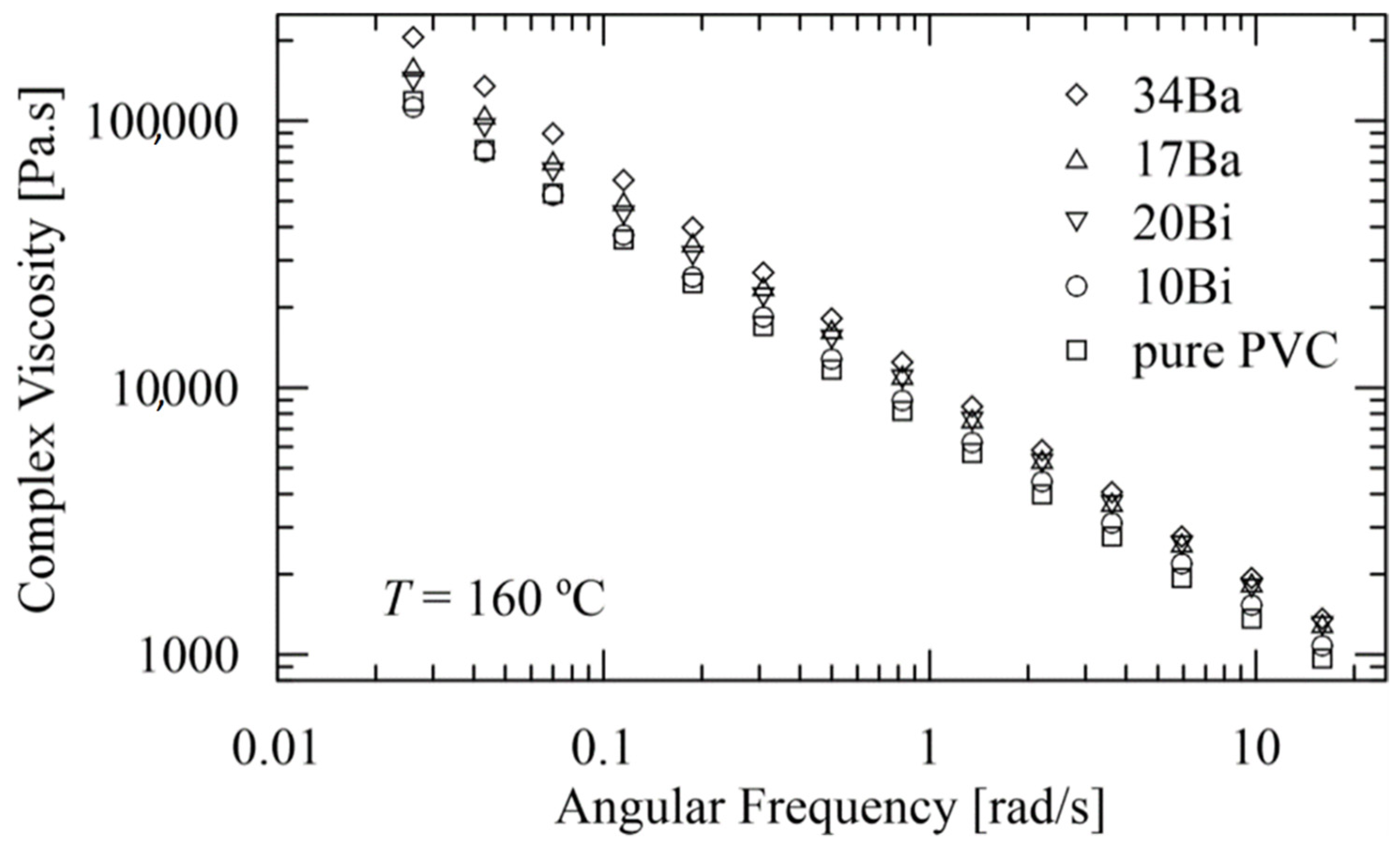
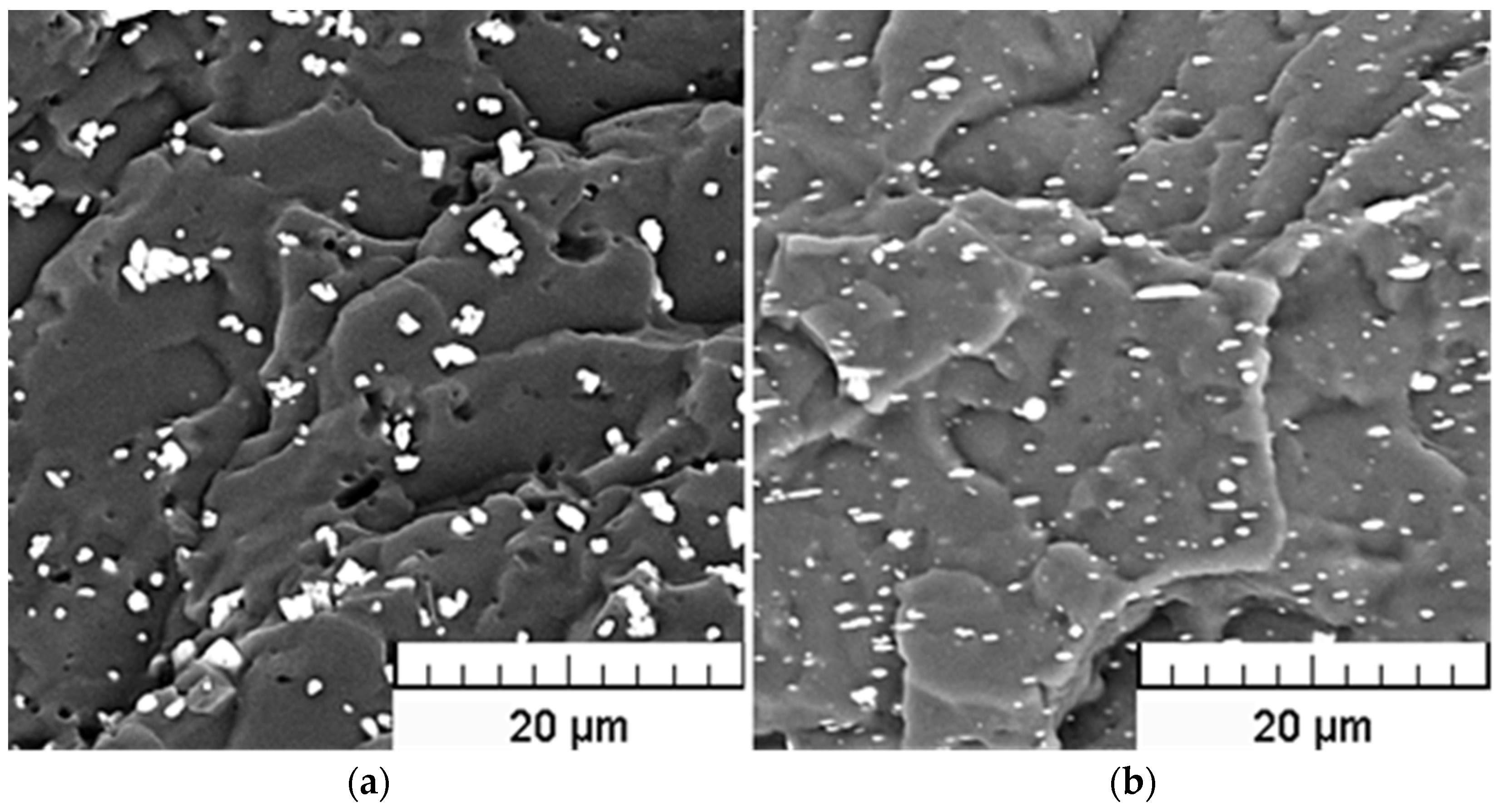

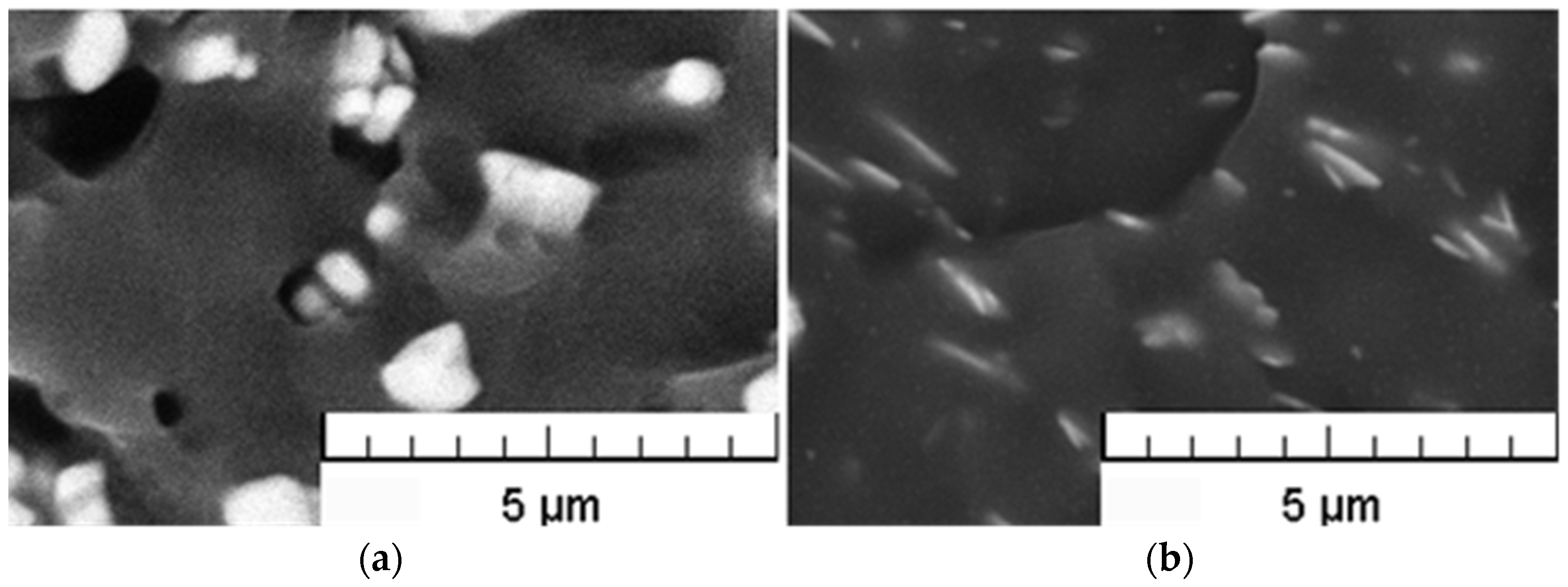
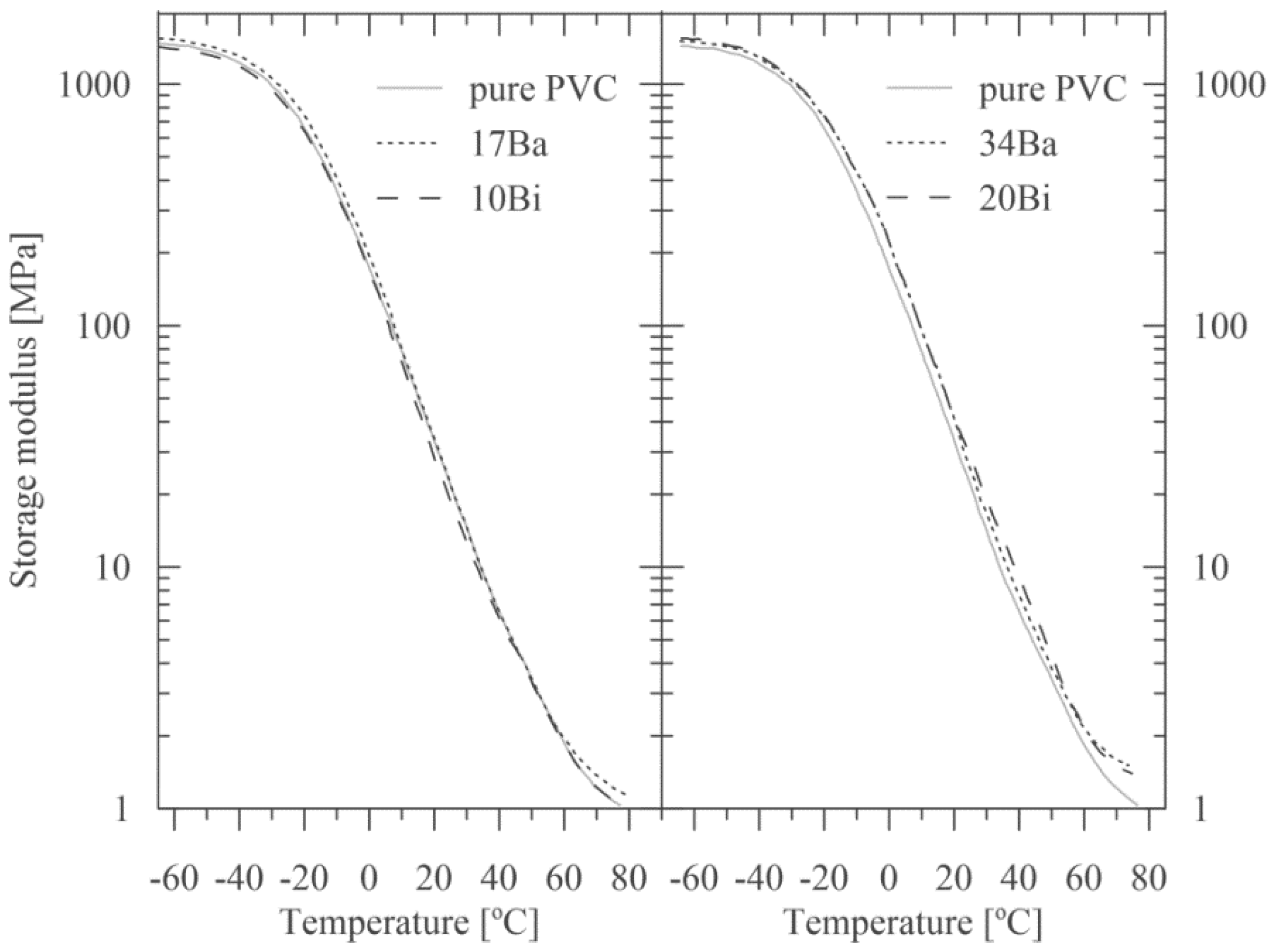
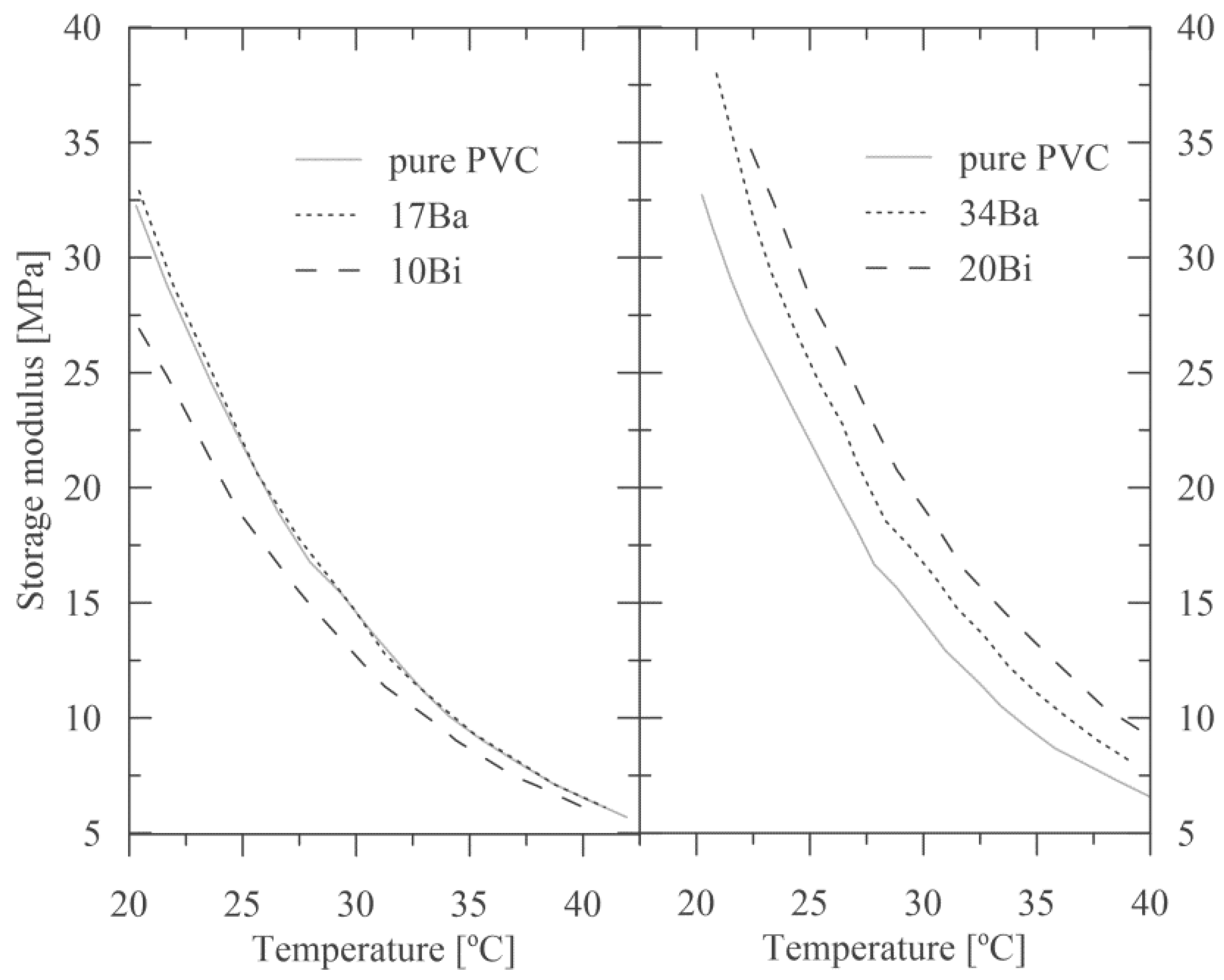
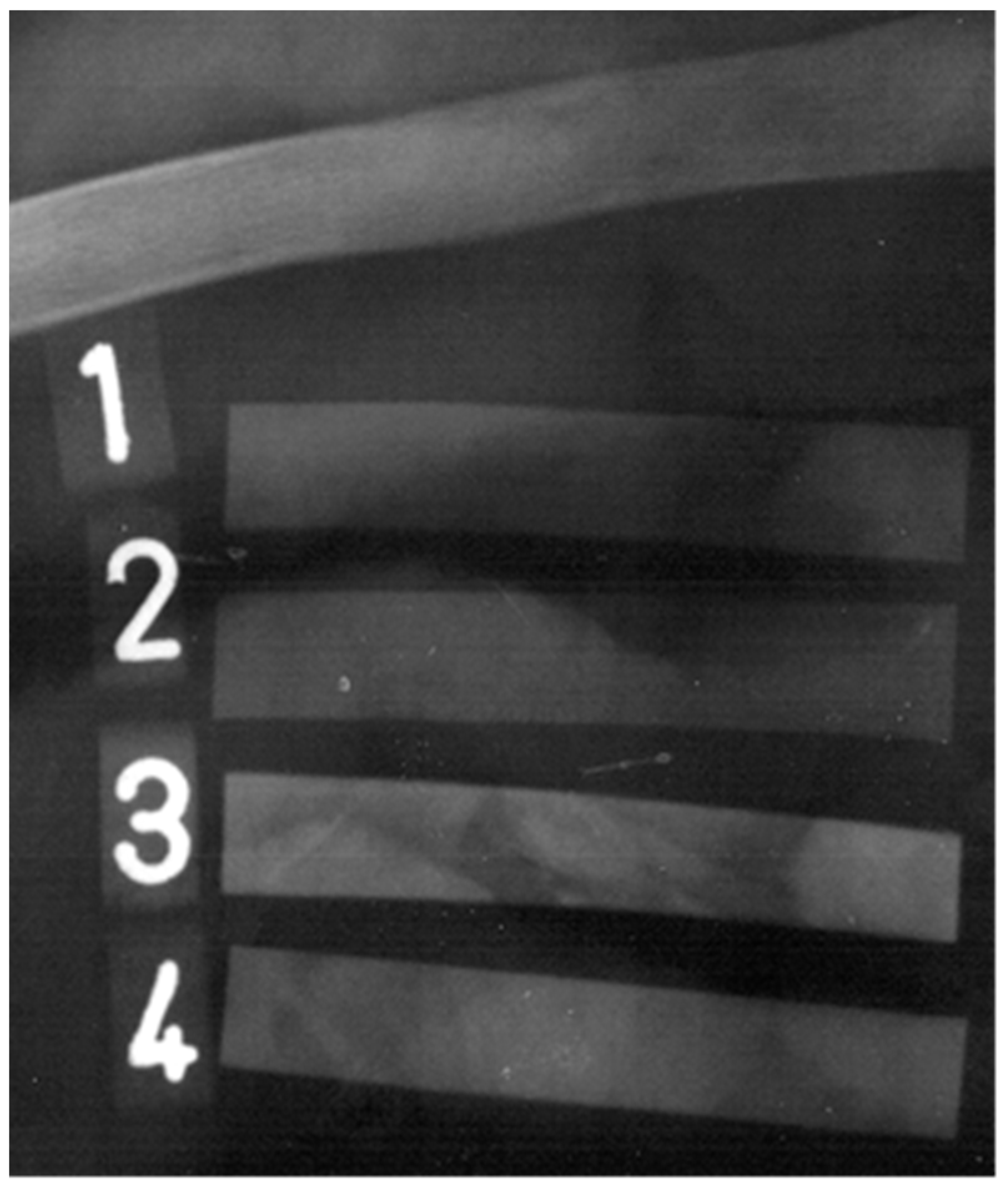
| Sample Label | BaSO4 (ρ = 4.5 g/cm3) | BiOCl (ρ = 7.7 g/cm3) | ||
|---|---|---|---|---|
| wt.% | vol.% | wt.% | vol.% | |
| Pure PVC | - | - | - | - |
| 17Ba | 17 | 5.3 | - | - |
| 34Ba | 34 | 12.3 | - | - |
| 10Bi | - | - | 10 | 1.7 |
| 20Bi | - | - | 20 | 3.8 |
| Material | Notation | Parameter a |
|---|---|---|
| Pure PVC matrix | PVC | 3.86 |
| PVC matrix + 17 wt.% BaSO4 | 17Ba | 3.99 |
| PVC matrix + 34 wt.% BaSO4 | 34Ba | 4.03 |
| PVC matrix + 10 wt.% BiOCl | 10Bi | 3.88 |
| PVC matrix + 20 wt.% BiOCl | 20Bi | 3.96 |
| Material | Tg [°C] | tan δ |
|---|---|---|
| Pure PVC | 24 | 0.42 |
| 17Ba | 22 | 0.46 |
| 34Ba | 23 | 0.46 |
| 10Bi | 22 | 0.46 |
| 20Bi | 24 | 0.42 |
Disclaimer/Publisher’s Note: The statements, opinions and data contained in all publications are solely those of the individual author(s) and contributor(s) and not of MDPI and/or the editor(s). MDPI and/or the editor(s) disclaim responsibility for any injury to people or property resulting from any ideas, methods, instructions or products referred to in the content. |
© 2023 by the authors. Licensee MDPI, Basel, Switzerland. This article is an open access article distributed under the terms and conditions of the Creative Commons Attribution (CC BY) license (https://creativecommons.org/licenses/by/4.0/).
Share and Cite
Polaskova, M.; Sedlacek, T.; Polasek, Z.; Filip, P. Modification of Polyvinyl Chloride Composites for Radiographic Detection of Polyvinyl Chloride Retained Surgical Items. Polymers 2023, 15, 587. https://doi.org/10.3390/polym15030587
Polaskova M, Sedlacek T, Polasek Z, Filip P. Modification of Polyvinyl Chloride Composites for Radiographic Detection of Polyvinyl Chloride Retained Surgical Items. Polymers. 2023; 15(3):587. https://doi.org/10.3390/polym15030587
Chicago/Turabian StylePolaskova, Martina, Tomas Sedlacek, Zdenek Polasek, and Petr Filip. 2023. "Modification of Polyvinyl Chloride Composites for Radiographic Detection of Polyvinyl Chloride Retained Surgical Items" Polymers 15, no. 3: 587. https://doi.org/10.3390/polym15030587
APA StylePolaskova, M., Sedlacek, T., Polasek, Z., & Filip, P. (2023). Modification of Polyvinyl Chloride Composites for Radiographic Detection of Polyvinyl Chloride Retained Surgical Items. Polymers, 15(3), 587. https://doi.org/10.3390/polym15030587







